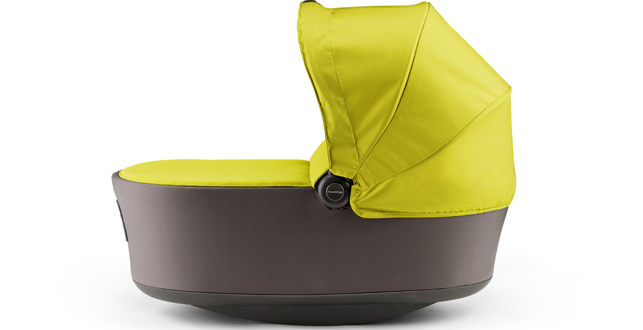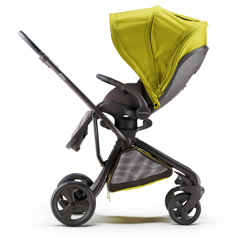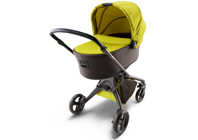Pram-tastic!

The Mylo begins with a baby’s carrycot, before adapting into a pram then pushcahir as the child develops
Prams have come a long way since the chrome-plated juggernauts pushed around by Mary Poppins and now serve as uber-functional, consumer friendly modern products.
A great example is the Mylo from Mamas & Papas, whose chassis can wheel around a baby’s carrycot in the early days and then transform into a pushchair as the child grows.
This overhaul of the traditional pram design and its re-imaging as a ‘baby transport solution’ was the first product overseen by Amanda Scacchetti, the eldest daughter of company founders David and Luisa.

The design is an interchangeable parenting marvel
Working with design consultancy DCA, the brief was for a pram that puts the baby at centre stage and designing from the seat and carrycot outwards, rather than from the frame in – making the comfort of the baby a priority.
“Working from a brief, the team at DCA ran a scoping exercise to explore new manufacturing methods as well as understanding the needs of consumers and users,” says Amanda.
“Once the concept was approved, the team began to design and ‘CAD’ each component, and our internal design team designed the soft seat and all the fabric accessories.”
The sketches were transformed into SolidWorks models where testing using Cosmos could take place.
“When designing a pushchair every aspect is interlinked,” explains DCA creative director, Nick Mival. “So what might seem the smallest visual change may stop the product folding up.
“Using SolidWorks enabled our engineering team to constantly check the pushchair functionality in a virtual environment as well as through real prototyping.”
The ‘real’ prototyping was at the heart of getting the product to market. “From early ‘pins’n’pipecleaners’ creative workshop tools through many iterations of FDM prints and SLS components, to very advanced prototyping of two hundred components in material correct components. At DCA prototyping is at the heart of what we do, literally the workshop is in the centre of the building!”
The end product is an interchangeable parenting marvel that still adheres to Mamas & Papas’ design ethic.
As Amanda puts it: “Mamas & Papas do not adhere to the belief that aesthetically driven individuals will abdicate their good taste and style values once the hormones are flowing and a baby arrives.”
Precious cargo
Transporting an infant in the family hatchback is the stuff of nightmares for most parents, which is why a secure baby seat is key.
The key brief for designers is to provide a secure shell and restraints in the case of an accident, but the seat must also be comfortable enough for a child to travel in.
The Britax Baby-Safe Plus SHR II has all this in place and more, with special attention paid to impact zones, and the threat posed by a collision to the seat from the side.

A key feature of the Baby-Safe Plus SHR II is a device called ‘D-SIP’ which significantly improves restraint performance on side impact
“The hero feature introduced on the Baby-Safe Plus SHR II is a device called ‘D-SIP’ which improves restraint performance on side impact significantly,” explains Richard Frank, Britax European engineering director, from its design centre in Germany.
“By having that technology in place, the kinematics of the child restraint system and the baby is much better controlled. By having the system being linked to the car’s accelerations and crash phases, delta velocities of the system to the car and intruding door are kept at a minimum.
“At the same time, the D-SIP transfers and distributes forces generated by the applied acceleration and system masses more beneficial to the structure of the Baby Safe shell to avoid load spots and stress areas on product and child.”
Before any designs take shape a clear target-related brief is drawn up based on analysis of existing products, respective behaviour and test results on different side impact load cases.
Catia V5, supported by Rhino, enabled the majority of the modelling, but it was the virtual analysis using Madymo and LS Dyna simulation tools that really progressed the seat’s development.
“All tools and methodology applied are kind of standards in automotive, specifically in fields of restraint systems,” says Richard. “Computer aided engineering was key for analysis and evaluation of key changes and validation of component and product design.
“By having the load cases/environment validated by a number of tests the accuracy of the simulation result versus hardware test has got a very satisfactory level of about 2% – 5% deviation.”
It takes a lot of engineering, calculations and testing to ensure that your baby’s seat is the most protected in the vehicle and your precious cargo is safe and sound.
Cradle to behave design
An infant squealing with delight as food is flung from a highchair is a demon best avoided – but at what age should the little angels be placed in one?

Drawing inspriation from classic furniture design bloom’s fresco highchair is able to safely cradle a baby straight from birth
This was one of the questions facing bloom, a business started by four dads who felt that products designed for their children hadn’t changed in 20 years, and lacked the innovation and progress of other consumer products.
Through research bloom found that an infant should be using a highchair at around six months old when babies’ necks are sufficiently developed to hold their heads up properly. However most parents actually buy the highchair when the child is only three months old. so the dads set out to design a highchair that would safely cradle the baby and be usable straight from birth.
“The design leads have quite a lot of experience in designing products for the world’s top brands,” says Jon Lake, co-founder, bloom, in relation to his company’s fresco chair. “In this case, they move quite quickly from rough pencil thumbnail sketches to CAD modelling, the modern 3D sketching tool.”
Instead of choosing the cheap vinyl and plastic covered tubing common with most baby chairs bloom’s designers looked to establish their own aesthetic drawing on the work of the past decades from design greats such as Ray and Charles Eames, Verner Panton, and Eero Saarinen.
Working with Alias, Pro/Engineer, Solidworks, and Rhino – whatever each designer was most comfortable with – the chair was first modelled, and then a wide variety of rapid prototyping techniques were used to build a working chair to help solve ergonomic issues.
“Children grow very fast so there is a broad range for the typical life of a product,” explains Jon “Getting the very best fit usually requires quite a lot of testing and evaluation.
“After using ergonomic models, we also check with a variety of kids. Fortunately, we have a large pool to select from: our own children are our most popular test subjects!”
The end product helps include babies in the social areas of the home – as a cot from its first days, straight through to a launch pad for flinging yoghurt months later.

The latest products to keep babies safe, and out of mischief






